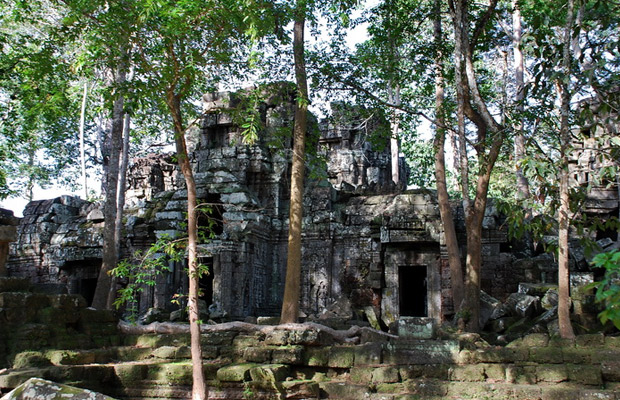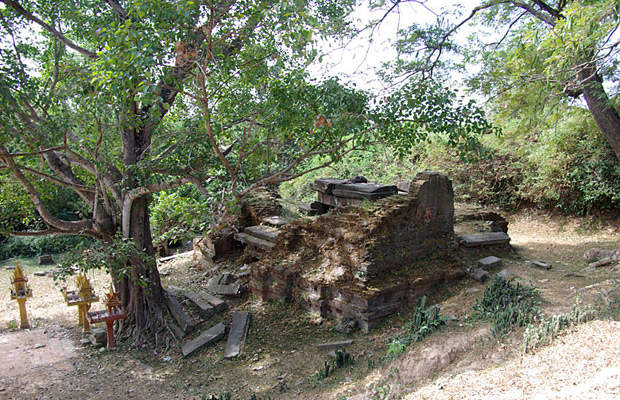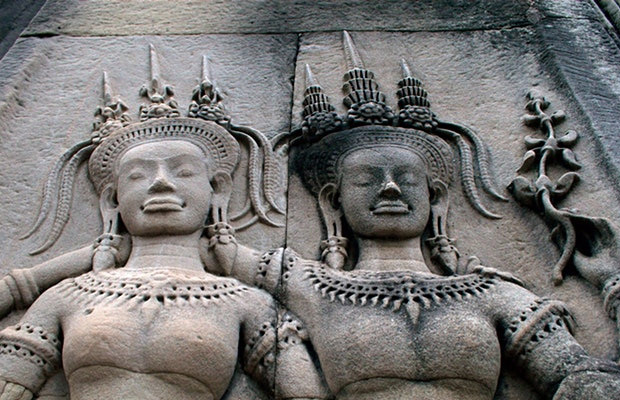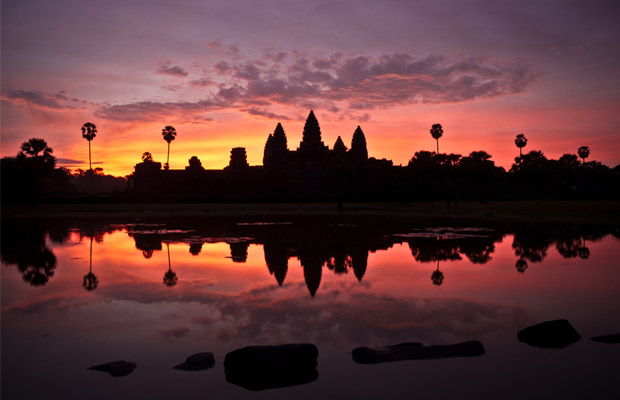Thommanon
Thommanon is one of two Hindu temples built during the reign of Suryavarman II (1113-1150) in Angkor, Cambodia. [1]: 119 This small and elegant temple is located east of the Victory Gate of Angkor Thom and north of Chau Say Tevoda. It is part of the UNESCO World Heritage, inscribed by UNESCO in 1992, entitled Angkor. The temple is dedicated to Shiva and Vishnu.
Thommanon is one of two Hindu temples built during the reign of Suryavarman II (1113-1150) in Angkor, Cambodia. [1]: 119 This small and elegant temple is located east of the Victory Gate of Angkor Thom and north of Chau Say Tevoda. It is part of the UNESCO World Heritage, inscribed by UNESCO in 1992, entitled Angkor. The temple is dedicated to Shiva and Vishnu.
History
Scholars who study the sculptures of the devatas in Thommanon concluded that Thommanon was built around the time when work at Angkor Wat was initiated. [3] However, there is some disagreement as to the precise date on which it was built. Some believe that the distinctive female sculptures, known as devatas, indicate that they were built during the reign of Jayavarman VI (1080-1113 AD), some time at the end of the 11th century. However, there is a greater agreement, especially taking into account the academic studies which was built by Suryavarman II around the time of Angkor Wat and Beng Mealea from 1111-150 AD
The Vaishnavite cult was adopted in Cambodia by Jayavarman II and his son Jayavarman III. Under these two rulers, the shaivite cult was subsumed with the Vaishnavite worship in temples such as Thommannon, Beng Mealea, Chau Say Tevoda, Banteay Samre, and Angkor Wat.
Thommanon is located opposite the Chau Say Tevoda and just 500 meters east of Victory Gate, on the way to Ta Keo. In the 1960s, the temple underwent a complete restoration, funded by the École française d'Extrême-Orient (EFEO). French archaeologists have restored and added concrete ceilings.
Structure
Thommanon is a one-tower temple with a central shrine oriented to the east, crowned by a prasat or tower. Access from the east is through a gopura, followed by a mandapa or antechamber, before arriving at the central sanctuary. [3] The temple sculptures are very well preserved and the aged sandstone provides a distinct contrast with the surrounding jungle. The architectural style of its tower is also similar to the temple of Angkor Wat and the nearby Chau Say Tevoda. [6] The temple is better preserved than the nearby Chau Say Tevoda, although both temples are similar in design. The reason for Thommanon's better preservation is attributed to the fact that its superstructure does not have wood beams enclosed in stone. Thus, the adoption of sandstone as a medium for sculptures in this temple made it more advanced in its architectural design compared to other nearby temples, which were mainly wood. All doors include carved pediments.
The compound walls around the temple disappeared, leaving only the entrance gates in the east and west; The central tower is all that remains of the main temple. It is inferred that Thommanon and Chau Say Thavoda were interconnected to the central tower under a large compound with large gates. The separate building separate from the main temple was the library.
Devatas
Left: Female Devatas in a corner panel showing with two different types of skirts. Law: More representations of female Devatas.
Images of Devatas, female divine figures, are seen in profusion here, as in other Khmer temples. They are the center of attraction in Thommanon. The devatas depict flower crowns, sampots, necklaces, armbands, belts and ankle bands. [4] The mudras displayed are complex. The devatas grasp the flower very distinctly, holding the ring and the middle fingers against the thumb, while the index finger and small finger are extended. An Angkor researcher calls this position the "devata mudra", and notes that it is also prominent in Angkor Wat. The first of the devatas are divided into two distinct types of sampot, a type is the old pleated style, seen in the period of Bakheng in Lolei and Phnom Bok (900 AD), and the other is a patterned fabric style with folds and "tail" in Angkor Wat. [4]
View Mores Temple Guide

Prasat Kra Chap
Prasat Kra Chap is a compact temple comprising two rather well preserved gopuras and the ruins of five towers arranged in a quincun. Thanks to the surviving inscriptions on the doorframes, we know ...

Mechrey Floating Village
Siem Reap is famous for not only the ancient Khmer temples, but also the unique floating villages on the bank of Tonle Sap, situated 9 kilometers west of Siem Reap. One of the three largest villages ...

Phnom Kulen Linga River
The 1,000-lingual river owes its name to the images of Hindu gods, their spouses and more than 1,000 slings carved into the bed and banks of the Siem Reap River in Phnom Kulen. The lanyards are a ...

Ta Nei
Ta Nei is a 12th century stone temple located in Angkor, Cambodia. Built during the reign of King Jayavarman VII, it is located near the northwest corner of East Baray, a large sacred reservoir. It ...

Prasat Ak Yum
Ak Yum (Khmer: ប្រាសាទអកយំ) is an ancient temple in the Angkor region of Cambodia. [2]: 350,352 Helen Jessup dates from the temple until the 8th century and states that it is ...

Bakong Temple
Bakong (Khmer: ប្រាសាទបាគង) is the first mountain of the sandstone temple built by the rulers of the Khmer empire in Angkor, near modern Siem Reap in Cambodia. In the last ...

Wat Preah Prom Rath Pagoda
Wat Preah Prom Rath is one of the most beautiful pagodas in Siem Reap. It is located on the river side, near the Old Market (Psar Chas). The monastery has many fine and colorful wall paintings and ...

Kbal Spean
Kbal Spean is an archaeological site of the Angkorian era on the southwest slopes of the Kulen Hills, northeast of Angkor, in the Siem Reap district of Siem Reap province, Cambodia. It is situated ...

Srah Srang
Srah Srang (Khmer: ស្រះស្រង់) is a baron or reservoir in Angkor, Cambodia, located south of East Baray and east of Banteay Kdei. It was excavated in the middle of the tenth century, ...

Banteay Thom
Banteay Thom is a lovely temple where the main appeal is its rural setting; It is only reached by sandy trails through rice and bush, where you are likely to seek a farmer, a buggy or anyone on the ...

Chau Say Tevoda
Chau Say Tevoda is a temple in Angkor, Cambodia. It is located east of Angkor Thom, directly south of Thommanon, through the Victory Path (before the previous date and post-dates). Built in the ...

Angkor Thom East Gate
The east gate of Angkor Thom was used as a location on the Tomb Raider, where the bandits entered the "tomb" pulling a giant polystyrene apsara. This is the most atmospheric of the gates of Angkor ...












